Enlarged Pores
In the nineteenth century, no advice on achieve and maintaining a flawless complexion would be complete without mentioning the skin’s pores – closing them, preventing blockages and clearing them when they became clogged. For many experts the need to this was more than cosmetic. Pores were regarded as openings through which ‘waste and refuse’ left the body so early beauty culturists believed that a person’s general health could be adversely affected if they were blocked.
The healthy condition, you are aware, not only of the skin itself, but of the whole body, depends on the healthy state of the pores or moisture-pipes, by which a large proportion of the waste and refuse of the body escapes in the form of insensible perspiration. Now, this refuse that comes to the skin, with the intention of obtaining a free passage by the pores, must be stopped there, if the pores are shut or obstructed, and, of course, an eruption will be the natural consequence, if the refuse, as is often the case, is not carried inwards again by the absorbents, in which case, an internal disease will be the result.
(Art of beauty, 1825, p. 156)
As well as excreting wastes, the pores of the skin were thought to be the openings through which the skin breathed and they were also a channel that could absorbed ‘skin foods’ from creams or lotions. This made them extremely important to the health of the skin.
See also: Skin Foods and Skin Breathing
Blocking the pores could ‘suffocate’ the skin, a peril that many soap companies levelled at make-up like face powders. In their battle with cosmetic companies for the cleansing market, soap companies would often return to this theme, the most extreme example being the Lever Brothers’ ‘Cosmetic Skin’ campaign started in 1934 for Lux soap.
See also: Cosmetic Skin
Pores
Unfortunately, when early beauty specialists talked about skin pores they frequently conflated the openings of two fundamentally different skin structures – sweat glands and sebaceous glands – and mixed up the functions of each.
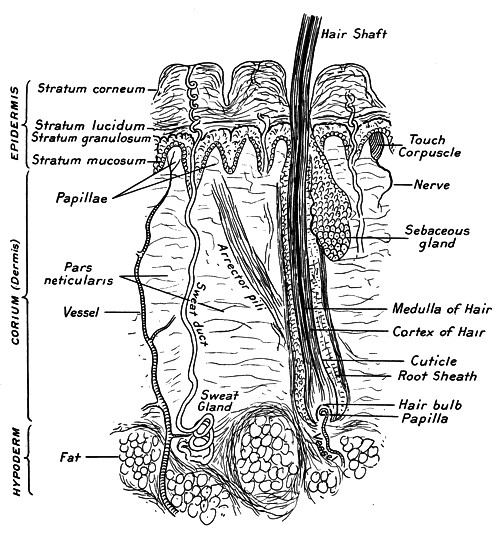
Above: Drawing of a cross-section of the skin showing the sebaceous and sweat glands and their pores.
On every square inch of the skin there are hundreds and hundreds of little openings, through which the perspiration finds an exit, or in which the hairs are planted. These openings lead to short canals which descend into the true skin. Besides the perspiration, the sides of these canals secrete a fatty substance which gives to the skin its oiliness and smoothness.
(Brinton & Napheys, 1870, p. 244)
Despite what may have been thought in the past, the pores of sweat glands are generally too small to be seen with the naked eye and usually do not become blocked. This contrasts with the larger, funnel-shaped openings of the sebaceous glands which are often very noticeable in places such as the nose and cheeks. It is these pores and their associated glands that are the cause of pimples, blackheads and acne, and are liable to become enlarged.
The conflation of sweat and sebaceous glands was by no means universal. By the twentieth century most beauty experts had concluded that the oily, sebaceous glands were the main problem when it came to enlarged pores, pimples and blackheads. Dirt and bacteria were seen as contributing factors so cleansing was regarded as an important part of any skin treatment.
Treatments
Early beauty experts often talked about ‘clogged’, ‘stagnant’, ‘sluggish’ or ‘congested’ skin when discussing the subject of blocked pores, pimples and blackheads. This reflects the belief that clogged pores were a symptom rather than a cause, and that the condition would only be resolved in the long run by improving the skin tone, getting the pores to function properly, and/or by boosting the general health of the skin.
Coarse pores are the result of a lack of tone in the skin. The pore openings are distended by effete matter which the pores are too sluggish to expel completely. For this reason, thorough cleansing is necessary to correct this fault and prevent blackheads and infections from developing in the languid pores.
(Parker, 1932, p. 25)
The thinking behind this approach viewed the relationship between the pores and the skin as two-way process. A build-up of wastes in the skin caused by ‘clogged’ pores could ‘stagnate’ the blood circulation. This would make the pores ‘sluggish’, ‘congesting’ the skin and exacerbating the original problem, which in turn would make it even more difficult for the pores to function properly. Consequently, cleansing was often accompanied by massage or patting to increase blood flow to the skin, and/or astringents or ice to improve the tone of the skin, stimulate it and close the pores. Many beauty writers erroneously thought that skin pores were opened and closed by muscles which could also be toned or tightened with ice or an astringent.
See also: Patters and Skin Tonics, Astringents and Toners
Exfoliation – through the use of a rough towel, flesh brush or a mild abrasive like almond meal – was also commonly recommended to deep cleanse the skin and remove any surface blockages in the pores.
Astringents primarily concern the pores of the skin. The pores are the openings of the sweat glands—very often too obviously open. When the pores are enlarged, the skin becomes coarse and invariably suffers from bad circulation of the facial blood vessels.
… To combat this defect, begin by making certain that the pores are free from excretions and foreign matter. Before retiring at night be especially careful to give the face a thorough cleansing treatment. …
To improve the circulation, follow the cleansing process with a stimulating treatment by patting the fleshy parts of the face with cold water or astringent.
It is essential to keep the pores free from dirt and dust during the day. Continued applications of soap and water are apt to aggravate the inherent coarse texture of a skin suffering from enlarged pores. The face should therefore be cleansed with oatmeal or almond meal, and then rinsed with water to which a small amount of astringent has been added. Apply “pore” cream to the face at night about twice a week. …
The enlarged pores are most obvious on the cheeks and around the nose. Apply the astringent generously but not too vigorously to the nose, and more energetically to the cheeks. …
Besides stimulating the activity of the pores, astringents and cold water assist the muscles to contract. This contraction makes the skin firmer and helps the glands to perform their duties of cooling the body and lubricating the skin.(Joslen, 1937, pp. 41-43)
Should blackheads (open comedones) be present then extractions might also be warranted.
See also: Blackheads
As well as cleansing, massage, steaming, toning and extractions, women could also purchase products specifically targeted at reducing the visible signs of skin pores. These included:
Pore creams, pastes and lotions: These commercial beauty products generally fell into one of two groups: those that used astringents to ‘close pores’, and those which acted as chemical exfoliants to remove obstructions to the free flow of sebum. Some products did both. Two example recipes are included below:
An Astringent Milk for Large Pores
Rose Water 6 oz. Elder Flower Water 2 oz. Tinct. Benzoin ½ oz. Tannic Acid 10 gr. (Woodbury, 1915, p. 24)
Astringent Milk for Enlarged Pores
Grammes Acetic acid 0.4 Salicylic acid 0.1 Alum 0.1 Jasmine compound 0.2 Alcohol 40° 99.2 (Gattefossé, 1959, p. 219)
Beauty clays: These became popular in the 1920s. They were spread on the face to form a thick coating and left on for 20 minutes or so before being washed off. The claims made for them – which included the elimination of blackheads and excess oil, and the removal of enlarged pores – were assisted by the fact that, like astringents, they produced a tightening sensation on the face as they dried. This is not to say they were not without some effect and if used correctly would have helped cleanse the skin and exfoliate it.
See also: Clay Masks
Salon treatments
Salon treatments for enlarged pores generally started with cleansing to clear the pores, and finished with an astringent to close them. Extractions to remove blackheads often formed part of the treatment. However, there were wide variations in suggested treatments which could also include:
Skin stimulation: Vacuum suction cups, red light treatment, massage, patters and faradic electrical treatments could be employed to help ‘stimulate the skin’ and ‘increase blood circulation’ to improve the overall health of the skin which would ‘encourage’ the pores to function normally.
Coarse Pore Astringent Treatment
1. Cleanse with Cream.
Use cup.
2. Remove comedones if necessary.
3. Apply astringent cream.
Pads over eyes.
Red light for 5 minutes.
4. Manipulations with faradic current for 15 minutes.
5. Remove cream with soda solution.
6. Apply astringent lotion with positive pole for 15 minutes.
7. Apply astringent lotion with pads of cotton and use patters for 10 minutes.
8. Apply make-up.(Smith & Rockwood, 1935, p. 114)
Galvanic treatments: Applying a positive electrode over the skin released an acid which was said to work as an astringent to help close enlarged pores, and as a germicide to help control bacteria.
Coarse Pore Astringent Treatment on Normal Skin
1. Cleansing Cream.
2. Remove cream.
3. Vapor face massage.
4. Remove blackheads, using a comedone extractor.
5. Almond meal pack mixed with coarse pore lotion. Let stand for 20 minutes.
6. Remove.
7. Apply tissue builder, astringent cream and bleaching cream, equal parts.
8. Manipulations.
9. Remove cream and use wall plate. Galvanic current, use roller electrode on face attached to the positive pole while customer holds electrode attached to negative pole for ten minutes.
10. Finish as plain facial.
11. Make-up.(Fulton, 1929, pp. 298-299)
The negative electrode was also used in some treatments. This electrode released an alkali (sodium hydroxide) which softened the keratin and helped remove plugs of sebum It was the basis behind the earlier use of the Electrolytic Cup and the later desincrustation treatments introduced into French beauty salons during the 1930s.
See also: Electrolytic Cup and Desincrustation
Home treatments
Women could also treat their enlarged pores at home. The description below is an example of an enlarged pore treatment from 1941. It does not use steaming to ‘open’ pores which was a common practice prior to extractions but does involve cleansing, extractions and disinfecting. Ice is used to ‘close the pores’ rather than an astringent. Soap was also used although many Beauty Culturists thought it was ‘drying’ and recommended it be avoided.
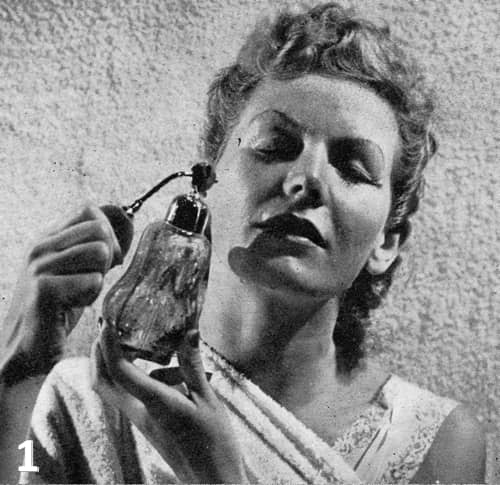
1. Prepare the skin for cleansing with rosewater or an astringent.
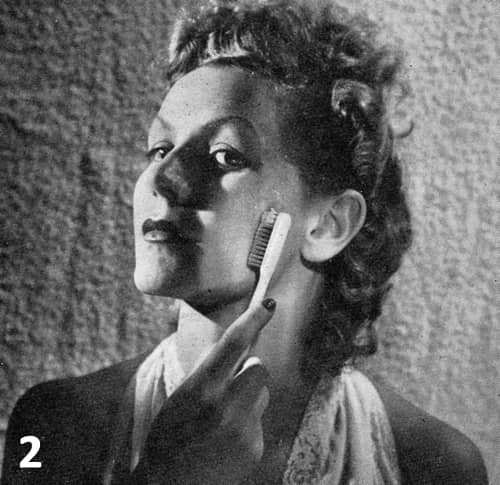
2. Cleanse the skin with soap using a small brush scrubbing gently in small circles.
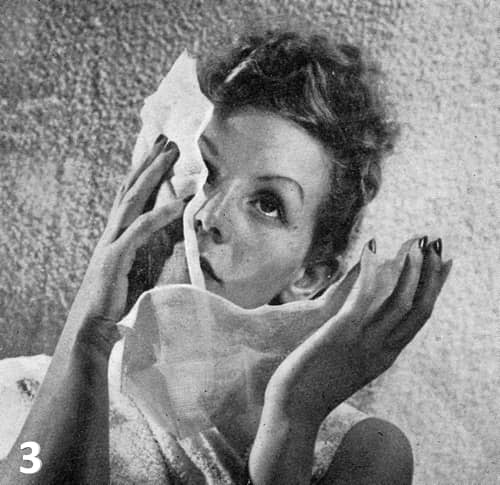
3. Remove the soap using water compresses or hot water.
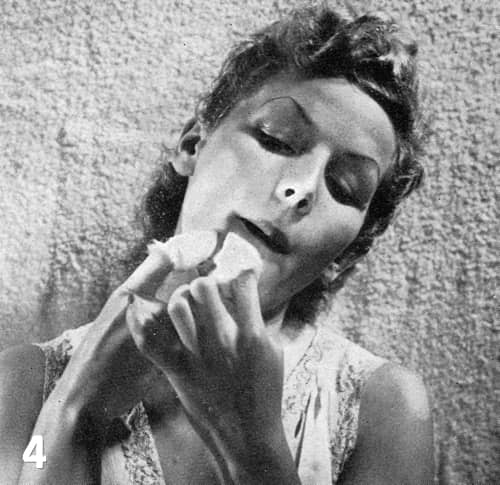
4. After cleansing, extract blackheads by pressing them out gently between two fingers covered in cotton wool.
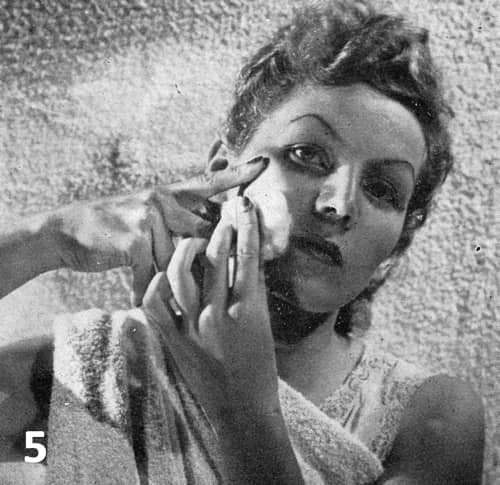
5. After extractions, apply an alcohol astringent to disinfect the skin.
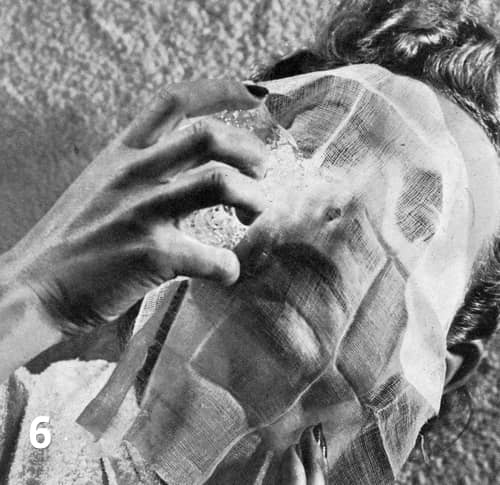
6. If the skin is normal or oily, massage with ice folded in a cloth to tighten the pores and tone up the skin.
Current practice
Enlarged pores should not be confused with the pores visible on normal skin associated with active sebaceous glands or with the pitting associated with acne scarring. Sex hormones, genetic predisposition, ageing, exposure to ultraviolet light and bacterial action are all contributing factors to their development. Unfortunately, there is little that can be done to shrink them once they appear. Some therapists still advocate the use of astringents and galvanic currents as in days of old but if these treatments have any effect they are likely to be very short-term.
Keeping the skin clean so that sebum flows freely can help prevent pores from getting stretched in the first place and there are indications that enlarged pores can repair themselves over time, at least in some people.
Updated: 21st August 2018
Sources
The art of beauty. (1825). London: Knight and Lacey.
Brinton, D. G., & Napheys, G. H. (1870). Personal beauty: How to cultivate and preserve it in accordance with the laws of health. Springfield, Mass: W. J. Holland.
Fulton, V. N. (1929). Rainbow text book of beauty culture. (2nd ed.).Indianapolis, IN: The Zinna Graphic Press.
Gattefossé, R. M. (1959). Formulary of perfumes and cosmetics. (Trans.). New York: Chemical Publishing Co., Inc.
Joslen, S. (1937). The way to beauty. A complete guide to loveliness. New York: Pitman Publishing Corporation.
Parker, J. (1932). The index to loveliness. New York: John H. Woodbury, Inc.
Smith, A., & Rockwood, R. (1935). Modern beauty culture. New York: Prentice Hall.
Uhoda, E., Piérard-Franchimont, C., Ludivine Petit, L., & Piérard, G. E. (2005). The Conundrum of Skin Pores in Dermocosmetology. Dermatology, 210, 3-7.
Woodbury, W. A. (1915). The care of the face. How to have clear, healthy skin and how to eradicate blemishes of the face and feature. New York: G. W. Dillingham Company.
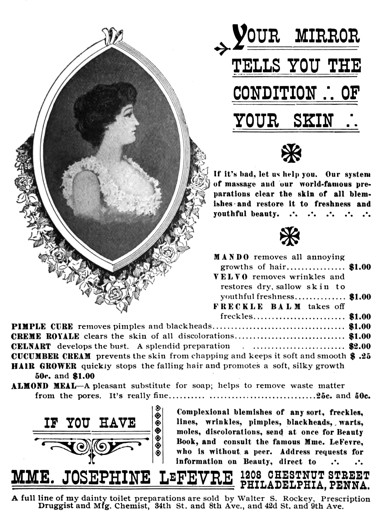
1904 Josephine LeFrevre Pimple Cure removes pimples and blackheads.
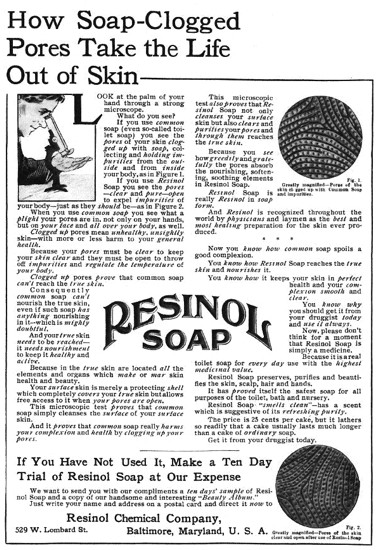
1904 Resinol Soap. The pores pictured are from sweat glands and are unlikely to be clogged.
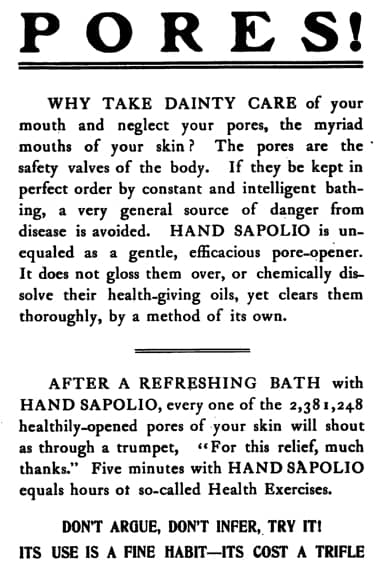
1904 Hand Sapolio.

1912 Elizabeth Arden Venetian Pore Cream.

1916 Helena Rubinstein complexion treatments including Valaze Blackhead and Open Pore Paste.
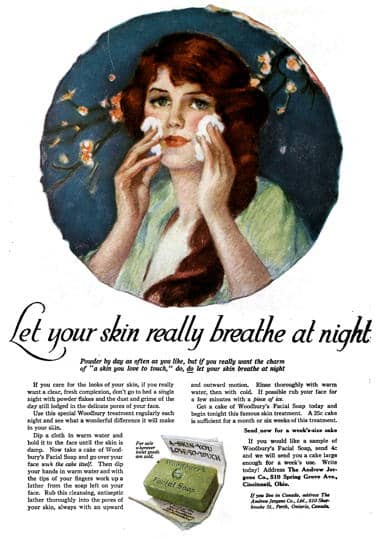
1917 Woodbury Soap.
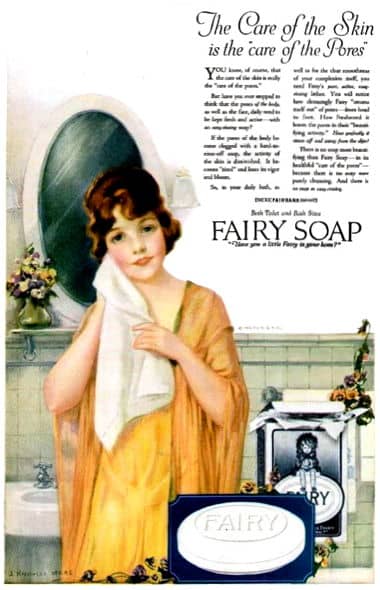
1920 Fairy Soap.
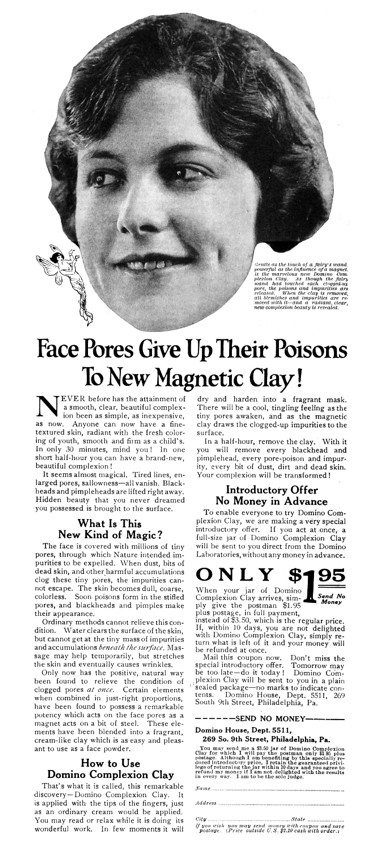
1922 Domino Complexion Clay.
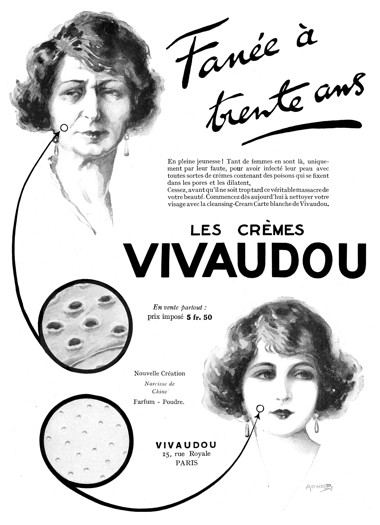
1924 Vivaudou. The message behind this advertisement is that enlarged pores make your skin old.
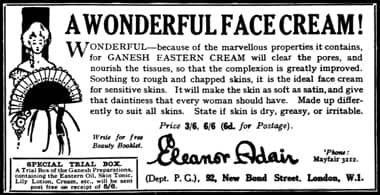
1925 Eleanor Adair.
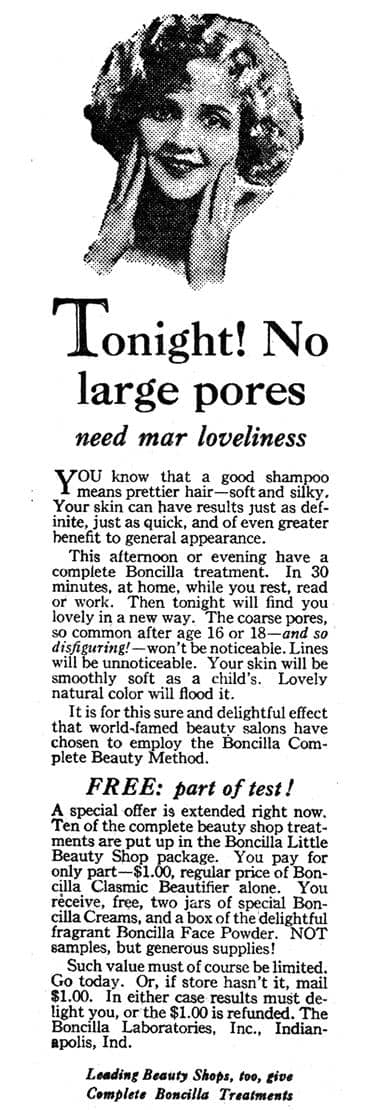
1927 Boncilla Complete Beauty Method.
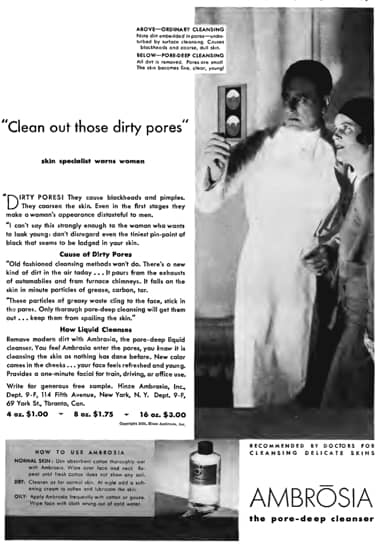
1930 Ambrosia liquid cleanser.
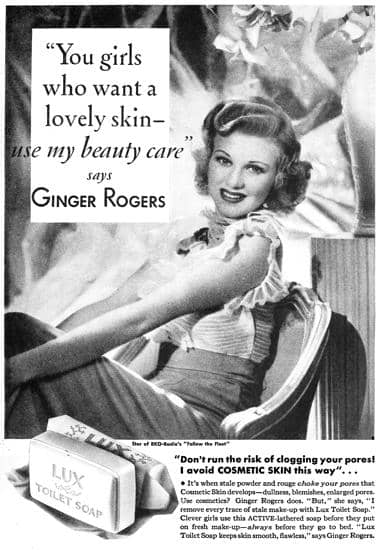
1936 Lux Soap. This advertising campaigned suggested that cosmetics blocked the pores and that only soap could remove it.
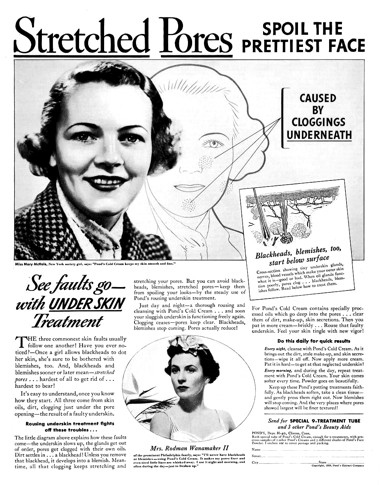
1936 Pond’s Cold Cream. “Rouse that sluggish underskin”.
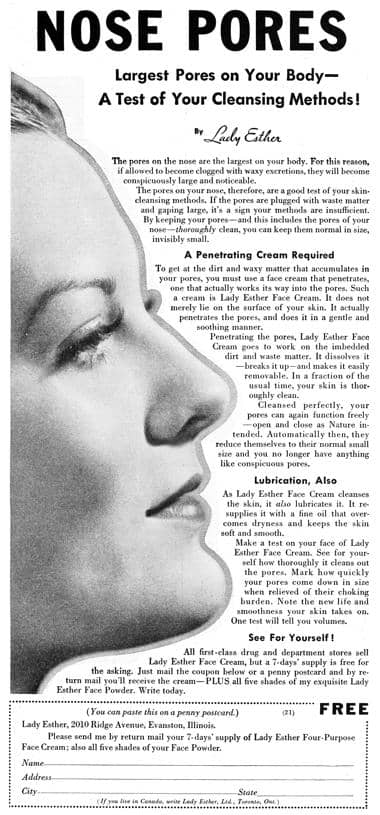
1936 Lady Esther Face Cream.

1937 Daggett & Ramsdell Perfect Cold Cream.
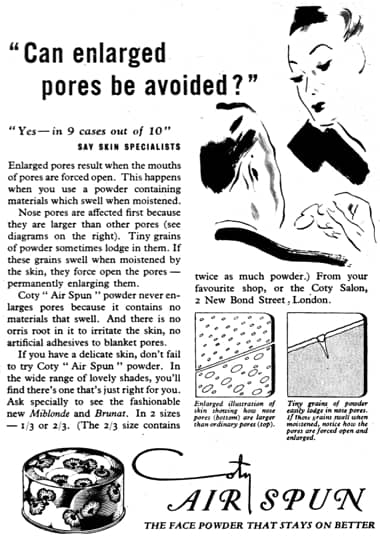
1938 Coty Air-Spun Face Powder. Coty is suggesting that organic ingredients in face powders such as starches could swell causing enlarged pores.
